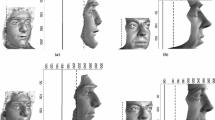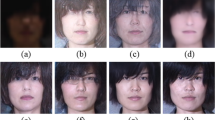Abstract
It has been known that it is hard to capture the high-frequency components (shadows and specularities) during the modeling of illumination effects. In this paper, we propose a reflectance model to simulate the interaction of light and the facial surface under the assumption that face is strictly axial symmetry. This model works well not only in fitting the intensities of pixel but also in processing the DC component contained in the image. To compute a facial 3D shape, we first augment the input images to get a symmetric facial normal field, then propose a method to obtain a more accurate normal field, and finally compute an integrable shape using the field. Experimental results for face relighting, facial shape recovery demonstrate the effectiveness of our method.
Access this chapter
Tax calculation will be finalised at checkout
Purchases are for personal use only
Preview
Unable to display preview. Download preview PDF.
Similar content being viewed by others
References
Georghiades, A.S., Belhumeur, P.N., Kriegman, D.J.: From Few to Many: Illumination Cone Models for Face Recognition under Variable Lighting and Pose. IEEE Transactions on Pattern Analysis and Machine Intelligence 23, 643–660 (2001)
Basri, R., Jacobs, D.W.: Lambertian Reflectance and Linear Subspaces. IEEE Transactions on Pattern Analysis and Machine Intelligence 25, 218–233 (2003)
Kemelmacher-Shlizerman, I., Basri, R.: 3D Face Reconstruction from a Single Image Using a Single Reference Face Shape. IEEE Transactions on Pattern Analysis and Machine Intelligence 33, 394–405 (2011)
Kumar, R., Barmpoutis, A., Banerjee, A., Vemuri, B.C.: Non-Lambertian Reflectance Modeling and Shape Recovery of Faces Using Tensor Splines. IEEE Transactions on Pattern Analysis and Machine Intelligence 33, 553–566 (2011)
Frankot, R.T., Chellappa, R.: A Method for Enforcing Integrability in Shape from Shading Algorithms. IEEE Transactions on Pattern Analysis and Machine Intelligence 10, 439–451 (1988)
Nilsson, M., Dahl, M., Claesson, I.: The Successive Mean Quantization Transform. In: IEEE International Conference on Acoustics, Speech and Signal Processing, 2005. Proceedings(ICASSP 2005), vol. 4, pp. 429–432 (2005)
Zhao, W.Y., Chellappa, R.: Symmetric Shape-from-Shading Using Self-ratio Image. International Journal of Computer Vision 45, 55–75 (2001)
Kovesi, P.: Shapelets Correlated with Surface Normals Produce Surfaces. In: Tenth IEEE International Conference on Computer Vision (ICCV 2005), vol. 2, pp. 994–1001 (2005)
Author information
Authors and Affiliations
Editor information
Editors and Affiliations
Rights and permissions
Copyright information
© 2011 Springer-Verlag Berlin Heidelberg
About this paper
Cite this paper
Hu, J., Feng, G., Lai, J., Zheng, WS. (2011). Asymmetric Facial Shape Based on Symmetry Assumption. In: Sun, Z., Lai, J., Chen, X., Tan, T. (eds) Biometric Recognition. CCBR 2011. Lecture Notes in Computer Science, vol 7098. Springer, Berlin, Heidelberg. https://doi.org/10.1007/978-3-642-25449-9_6
Download citation
DOI: https://doi.org/10.1007/978-3-642-25449-9_6
Publisher Name: Springer, Berlin, Heidelberg
Print ISBN: 978-3-642-25448-2
Online ISBN: 978-3-642-25449-9
eBook Packages: Computer ScienceComputer Science (R0)




